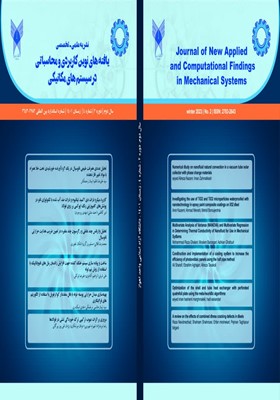بهینهسازی مبدل حرارتی پوسته-لوله با بافل منفذدار کواترفویل با استفاده از الگوریتمهای فراابتکاری
محورهای موضوعی : یافته های نوین کاربردی و محاسباتی در سیستم های مکانیکیسید ایمان هاشمی مرغملکی 1 , هادی اسکندری 2 *
1 - کارشناس ارشد، شرکت نفت و گاز اروندان، خرمشهر ، ایران.
2 - عضو هیئت علمی دانشگاه صنعت نفت ، آبادان، ایران.
کلید واژه: الگوریتم گرگ خاکستری, بهینه سازی چند هدفه, بافل منفذدار کواترفویل, الگوریتم ژنتیک, بهینه سازی تک هدفه,
چکیده مقاله :
در این پژوهش، مشخصه های حرارتی و هیدرولیکی سمت پوسته مبدل حرارتی پوسته-لوله با بافل منفذدار کواترفویل به وسیله الگوریتم های فراابتکاری گرگ خاکستری و ژنتیک به صورت تک هدفه و چند هدفه بهینه سازی می شود. تابع های هدف، ظرفیت انتقال حرارت برای مقدار بیشینه و اتلاف فشار برای مقدار کمینه می باشد. متغیرهای مبدل حرارتی پوسته-لوله برای بهینه سازی عبارتند از: قطر و تعداد لوله ها، عدد رینولدز، فاصله بین بافل ها و ارتفاع منفذ کواترفویل. مقادیر بهینه شده برای آرایش مربع و مثلث دسته لوله ها به دست آمده است. نتایج نشان داده است که برای بیشترین انتقال حرارت بافل کواترفویل مقادیر قطر لوله 03/0 متر، تعداد لوله ها 30 عدد، مقدار عدد رینولدز 20000، ارتفاع منفذ 0018/0 متر و فاصله بین بافل ها 15/0 متر است. برای کمترین مقدار افت فشار قطر لوله ها 03/0 متر برای آرایش مربع و 01/0 متر برای آرایش مثلث، عدد رینولدز 5000، ارتفاع منفذ 003/0 متر و فاصله بین بافل ها 25/0 متر است. در بهینه سازی چند هدفه قطر لوله ها 03/0 متر و تعداد لوله ها 30 عدد حاصل شده است. بهینه سازی به وسیله الگوریتم گرگ خاکستری والگوریتم ژنتیک نتایج یکسانی برای مبدل حرارتی پوسته-لوله با بافل کواتر فویل در بر داشته است.
In this research, the thermal and hydraulic characteristics of the shell side of the shell and tube heat exchanger with perforated quatrefoil plate are optimized by a gray wolf and genetic algorithms in a single-objective multi-objective manner. The objective functions are heat transfer capacity for the maximum value and pressure drop for the minimum value. Shell and tube heat exchanger variables for optimization are: the diameter and number of tubes, the Reynolds number, the distance between baffles, and the height of the quatrefoil hole. The results show that for the maximum heat transfer of the quatrefoil baffle, the tube diameter is 0.03 m, the number of tubes is 30, The Reynolds number is 20000, the height of the perforated hole is 0.0018 m, and the distance between the baffles is 0.15 m. For the lowest pressure drop value, the diameter of the tubes is 0.03 m for the square arrangement and 0.01 m for the triangle arrangement; the Reynolds number is 5000, the height of the perforated hole is 0.003 m, and the distance between the baffles is 0.25 m. The optimization by the gray wolf and genetic algorithms has the same results for the shell and tube heat exchanger with a quatrefoil baffle.
[1] Guo, W., Zhao, R., Hu, K., Huang, D., Zhao, Y., (2023), Two-phase refrigerant maldistribution and optimization design in novel alternatively-laminated-microchannel-tube (ALMT) heat exchangers with vertical headers. International Journal of Refrigeration.
[2] Mohapatra, S., Das, D. K. Singh, A. K. (2023), Mechanical design of plate-fin heat exchangers for industry using social learning chaotic based Kho-Kho optimization. Annals of Nuclear Energy 181: p 109517.
[3] Zhang, T., Chen, L., Wang, J., (2023), Multi-objective optimization of elliptical tube fin heat exchanger based on neural networks and genetic algorithm. Energy: p 126729.
[4] Feng, Y., Xu, R., Cao, Y., Wu, X., Liang, C., Zhang, L., (2023), Optimization of H-type finned tube heat exchangers with combinations of longitudinal vortex generator, dimples/protrusions and grooves by Taguchi method. International Communications in Heat and Mass Transfer 143: p 106709.
[5] Liu, P., Han, H., and Bao, Z., (2022), Multi-objective optimization of fuel–air tube-in-tube helical coil heat exchangers for cooled cooling air system applied in aeroengines. Aerospace Science and Technology 130: p 107933.
[6] Zhu, K., Chang, Z., ,Li M., Sun, L., Li, S., Xu, H., Xu, M., ,Sang M., Ye, R., Han, R., (2023), Design, optimization and experimental testing of 2 K cryogenic plate-fin heat exchanger. Applied Thermal Engineering 223: p 119973.
[7] Zaniewski, D., Klimaszewski, P., Klonowicz, P., Witanowski, Ł., Lampart, P., Jędrzejewski, Ł., Suchocki, T., (2023), Organic Rankine Cycle turbogenerator cooling–optimization of the generator water jacket heat exchange surface. Applied Thermal Engineering: p 120041.
[8] Zhengyong, J., Mengjie, S., Chaobin, D., Yuyan, J., Pun, W. M., Hang, C. C. Y., (2023), Two mathematical models of flow boiling and flow instability in rectangular expanding microchannel heat exchangers and structure optimization. Applied Thermal Engineering: p 120483.
[9] Rao, R. V., and Majethia, M., (2022), Design optimization of shell-and-tube heat exchanger using Rao algorithms and their variants. Thermal Science and Engineering Progress 36: p 101520.
[10] Zhang, X., Han, D., He, W., Yue, C. Pu, W., (2017), Numerical simulation on a novel shell-and-tube heat exchanger with screw cinquefoil orifice baffles. Advances in Mechanical Engineering 9(8): 1687814017717665.
[11] Jena, S., Patro, P., Behera, S. S. (2013), Multi-objective optimization of design parameters of a shell & tube type heat exchanger using genetic algorithm. International Journal of Current Engineering and Technology 3(4): pp 1379-1386.
[12] Wang, D., Wang, H., Xing, J., Wang, Y., (2021), Investigation of the thermal-hydraulic characteristics in the shell side of heat exchanger with quatrefoil perforated plate. International Journal of Thermal Sciences 159: 106580.
_||_
